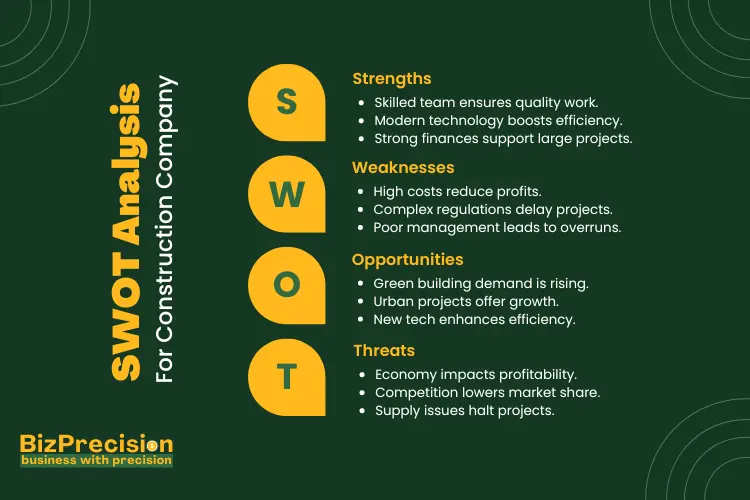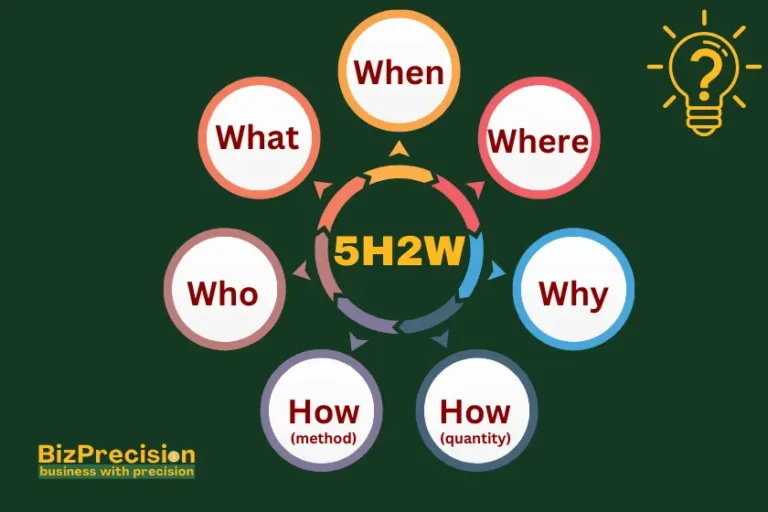Construction Company SWOT Analysis: Key Insights and Strategies
A few bad decisions can ruin a successful construction company. Doing a Construction Company SWOT Analysis helps to find strengths and weaknesses and avoid these mistakes.
Construction firms can gain a strategic advantage by proactively identifying threats and seizing growth opportunities. This article explains how SWOT Analysis can be a game-changer in the Construction Industry.
Overview of SWOT Analysis
Before using SWOT Analysis in Construction, let’s understand the basic principles and how they fit the industry.
This involves identifying the company’s strengths, weaknesses, opportunities, and threats. We’ll then examine how to use these to achieve long-term success.
Strengths: Consider assets like a skilled workforce, advanced technology, strong finances, and a good market reputation.
Weaknesses: Construction companies need better marketing, lower costs, better project management, fewer regulatory challenges, or more products.
Opportunities: This can be market expansion, new alliances, new products, or new infrastructure projects. These can be big game-changers for your construction company.
Threats: These are dangers like economic downturns, regulatory changes, intense competition, or currency changes.
Importance of Construction Company SWOT Analysis
SWOT Analysis is a powerful tool for construction firms. It not only helps them understand their strengths and weaknesses but also plays a crucial role in strategic planning, guiding them towards long-term success.
High costs, strict regulations, and tough competition affect these companies. The analysis identifies opportunities and threats and provides insights for better strategies. It empowers construction companies to face future challenges with confidence and preparedness.
Purpose of the Article
This article offers a comprehensive construction company SWOT analysis, highlighting key strengths, weaknesses, opportunities, and threats. It guides construction firms in understanding their position and creating effective strategies for success. Dive in to unlock insights and drive your company’s growth and resilience.

Strengths of Construction Companies
Strong Market Position
Many construction companies have a strong market position due to their solid reputation and branding. A reputable brand attracts loyal customers and referrals, building a reliable customer base.
Skilled Workforce
A skilled workforce delivers high-quality work. Ongoing training and development enhance their skills, keeping the company competitive.
Advanced Technology and Equipment
Construction companies invest in advanced technology and equipment, such as construction software. This investment improves project management issues, leading to efficient operations and higher-quality results.
Financial Stability
Financial stability is crucial for construction companies. Access to capital allows them to take on large projects. Strong cash flow management maintains operations and supports growth, helping companies handle economic fluctuations.
Competitive Advantages
Successful projects show that a contractor is reliable and competent. Showcasing a rock-solid project portfolio can build confidence among potential clients.
Ties with trusted suppliers ensure a steady flow of quality materials and on-time deliveries, demonstrating a commitment to quality and reliability.
Weaknesses of Construction Companies
High Operational Costs
Expensive operational costs are a significant area for improvement. These include the cost of materials and labor, which are often substantial. Overheads and administrative expenses add to the total cost, constantly challenging expense management.
Regulatory and Compliance Challenges
Another major issue in construction is regulatory challenges. Companies must adhere to safety standards, navigate permits, and meet legal requirements to avoid fines and legal disputes.
Project Management Issues
Project management in construction is crucial but often challenging. Delays, cost overruns, and communication issues can cause big problems.
Limited Innovation and Adaptability
Many construction firms resist change, making it hard to adopt new technologies. This resistance can hurt growth and competitiveness in a rapidly changing industry.
Workforce Constraints
Workforce constraints in construction can delay projects, reduce quality, and increase training costs. Higher labor costs can also cut profit margins, affecting a company’s efficiency and financial stability.
Opportunities for Construction Companies
Growing Demand for Sustainable Construction
The demand for sustainable construction is increasing. Technological advancements in construction offer new opportunities. Construction companies can use these trends to attract more clients and stand out.
Urbanization and Infrastructure Development
Urbanization creates many opportunities for economic development. More government-funded and private investments offer construction companies chances to work on large-scale infrastructure projects or public-private partnerships.
These projects include roads, bridges, and public buildings, providing extensive growth opportunities.
Technological Advancements
Technological advancements in construction offer new opportunities for innovation. Building Information Modeling (BIM) improves project planning and management, while drones and automation boost efficiency and safety. These technologies can significantly improve operations and project results.
Expanding into New Market
Expanding into new markets can help construction firms grow. This means taking on international projects and diversifying portfolios. By entering new areas and sectors, construction companies can reduce the risks of local market changes and create new revenue streams.
Sustainable Supply Chain Management
Optimizing logistics and adopting sustainable practices can reduce costs in the supply chain and promote environmental stewardship. Building solid relationships with reliable suppliers ensures the quality of materials and timely deliveries, further enhancing project efficiency.
Threats to Construction Companies
Economic Fluctuations
Economic fluctuations pose a significant threat to construction companies. Risk mitigation is key to handling these challenges, which affect profitability and project feasibility.
Competitive Market
The competitive market in construction allows emerging firms to engage in price wars and aggressive bidding, highlighting the importance of cost management in construction.
This competition can squeeze profit margins and reduce market share, demanding continuous improvement and innovation to remain at the forefront of the industry.
Supply Chain Disruptions
Supply chain disruptions, such as material shortages and delays, can stop projects. This shows the need for risk mitigation in construction. Construction firms should build strong relationships with suitable suppliers and have contingency plans for a robust supply chain.
Environmental and Climate Challenges
Environmental challenges in construction are becoming more significant. Construction companies must comply with regulatory requirements and adopt sustainable practices. Extreme weather conditions can delay projects, and strict ecological regulations require companies to be more sustainable.
Legal Disputes and Litigation
Legal issues can pose significant challenges for construction companies. Disputes over contracts, payments, and billing are common threats, as are delays, time extensions, and safety issues.
To reduce these risks, companies should write clear contracts, adhere to safety regulations, and seek legal assistance.
Strategies to Leverage Strengths and Opportunities
Investing in Workforce Development
Investing in workforce development helps construction companies build a skilled workforce, making them leaders in the industry. Regular training keeps employees updated on the latest techniques and technologies, improving project quality and increasing employee satisfaction and retention.
Continuous Training Programs: Regular training keeps employees updated with industry standards.
Employee Retention Strategies: Offering incentives and career growth opportunities helps employee retention.
Enhancing Technological Integration
Integrating advanced technology can significantly improve efficiency and productivity, leading to smoother operations and better project outcomes.
Adopting Cutting-Edge Tools: Investing in modern machinery and equipment, or cutting-edge tools, enhances precision and speed.
Implementation of Digital Solutions: Using project management and planning software, or digital solutions, increases efficiency.
Efficient Budgeting Practices: Efficient budgeting involves careful planning and monitoring to control costs.
Securing Diverse Funding Sources: Accessing different funding options, or securing diverse funding sources, ensures financial flexibility.
Expanding Market Reach
Expanding market reach opens new growth opportunities. Strategic partnerships and improved marketing attract new clients and projects, aiding in strategic planning for construction companies.
Strategic Partnerships: Effective strategic planning helps firms expand into new markets by collaborating with other firms or forming strategic partnerships.
Marketing and Branding Efforts: Effective branding and targeted marketing campaigns enhance customer loyalty and attract new business, which is vital for a Construction Company SWOT Analysis.
Strategies to Address Weaknesses and Threats
Cost Management Initiatives:
Implementing cost management in construction helps control high operational costs. Companies should streamline operations and cut unnecessary expenses to boost profits.
Streamlining Operations: Technological integration optimizes processes, reduces waste, and improves efficiency.
Implementing Cost-Saving Measures: Identifying and eliminating unnecessary expenses is critical to effective cost management in construction and better efficiency.
Regulatory Compliance Programs
Handling regulatory challenges in construction and preventing legal disputes ensures smooth projects. Regular audits and safety training help meet standards.
Regular Audits and Inspections: Regular audits ensure regulatory compliance and reduce project management issues.
Training on Safety Protocols: Training employees on safety standards ensures regulatory compliance and lowers risks.
Improving Project Management Practices
Tackling project management issues with innovation in construction reduces delays and costs.
Use of Project Management Software: Project management software addresses issues and integrates technological advancements in construction for better resource management.
Enhanced Communication Strategies: Clear communication reduces project management issues and aids strategic planning.
Risk Mitigation Plans
Risk mitigation in construction prepares companies for economic changes. Contingency planning and diversification minimize risk impacts.
Contingency Planning: Contingency planning ensures quick response and effective risk mitigation in projects.
Diversification to Minimize Impact: Diversifying services and markets reduces reliance on one income source, helping manage risks in the construction sector.
Case Studies: Applying SWOT Analysis in Construction Companies
Case Study 1: Streamlining Operations with Lean Techniques
Case Summary: This Construction Company’s SWOT Analysis shows how Bright Builders improved efficiency. Through the SWOT analysis, they identified strengths like skilled labor and quality materials and used these assets well.
Lean construction techniques addressed weaknesses like project delays and cost overruns, enhancing efficiency and reducing waste. The company also seized opportunities in green building technology, making it stand out in a competitive market. By diversifying its portfolio, it mitigated threats from economic downturns.
Outcome: This transformation led to a 30% reduction in project completion times and a 20% increase in customer satisfaction. Bright Builders’ proactive approach is an inspiring example of how a thorough SWOT analysis can drive significant operational improvements.
Citation: Smith, J. (2022). “Construction Success: Lean Techniques in Practice.” Construction Today.
Case Study 2: Expanding Market Reach with Strategic Planning
Case Summary: Strategic planning enabled new market expansion for construction. Skyline Construction used SWOT analysis to carve out a niche in the high-rise residential sector.
They emphasized their strength in innovation and addressed their need for more marketing expertise by hiring a dedicated team. The company capitalized on the growing demand for urban housing. It countered potential threats by forming strategic partnerships with key suppliers.
Outcome: Skyline Construction’s strategic planning and expansion efforts resulted in significant growth and market presence.
Citation: Johnson, A. (2021). “Market Expansion Strategies in Construction.” Builder’s Digest.
Lessons Learned from Failures
Construction failures highlight the need for proactive strategic planning. Companies have learned valuable lessons, such as avoiding poor planning, lack of innovation, and failing to adapt. Proactive strategies and continuous improvement are crucial.
Conclusion
A comprehensive Construction Company SWOT Analysis is essential for understanding the future outlook. It gives a detailed overview of a company’s strengths, weaknesses, opportunities, and threats.
By leveraging strengths, addressing weaknesses, and seizing opportunities, construction companies can navigate threats and achieve success. Regular SWOT analysis is necessary in the changing construction landscape.






